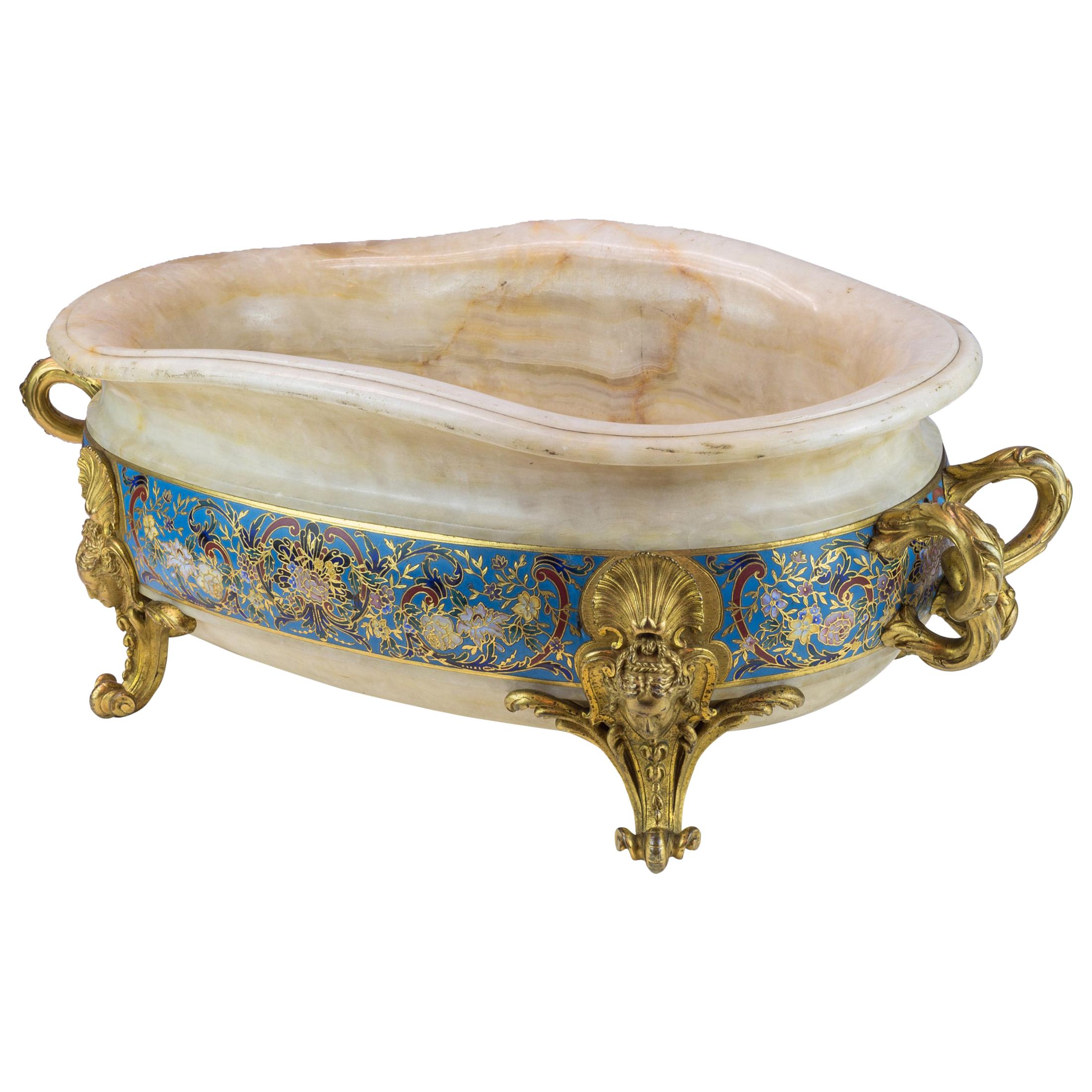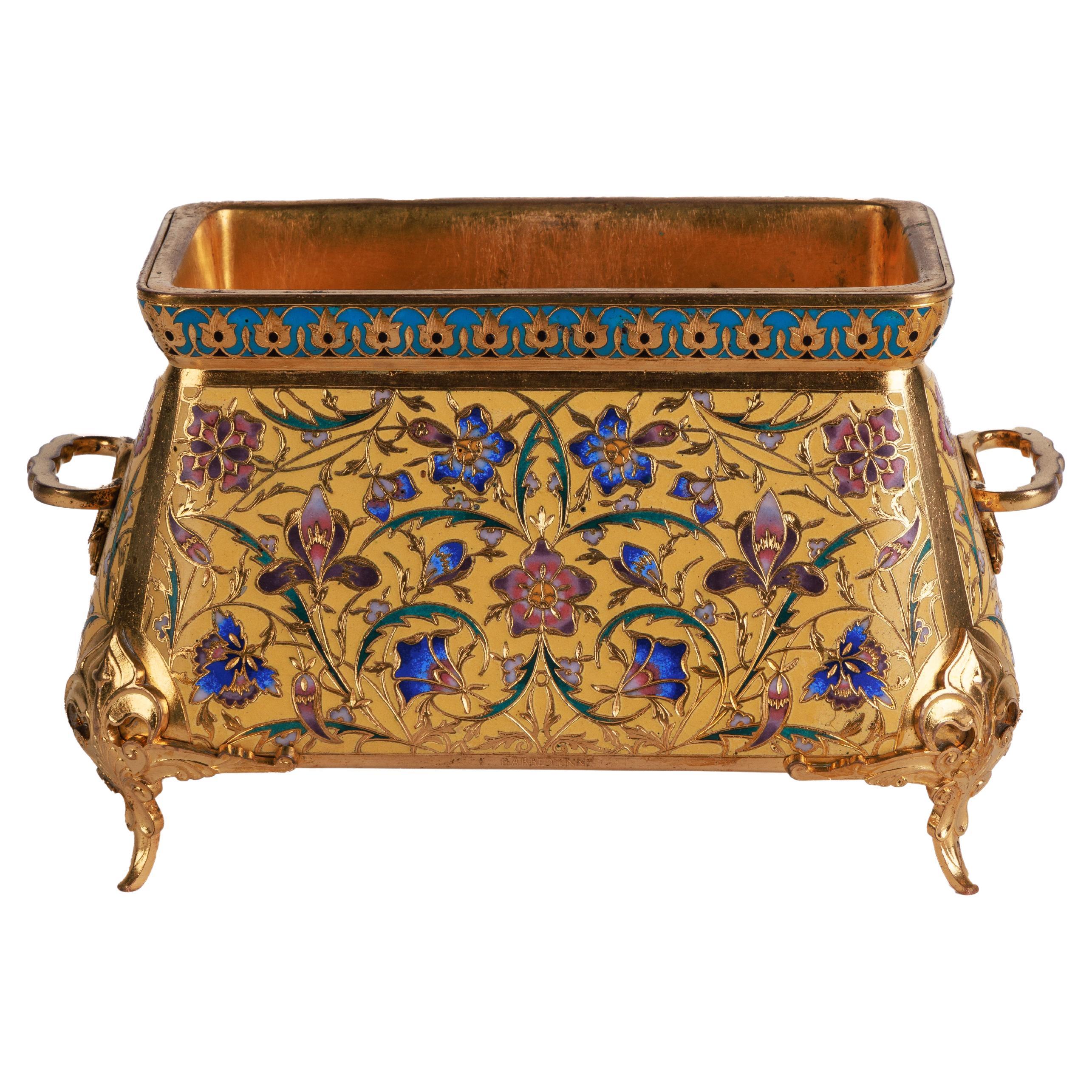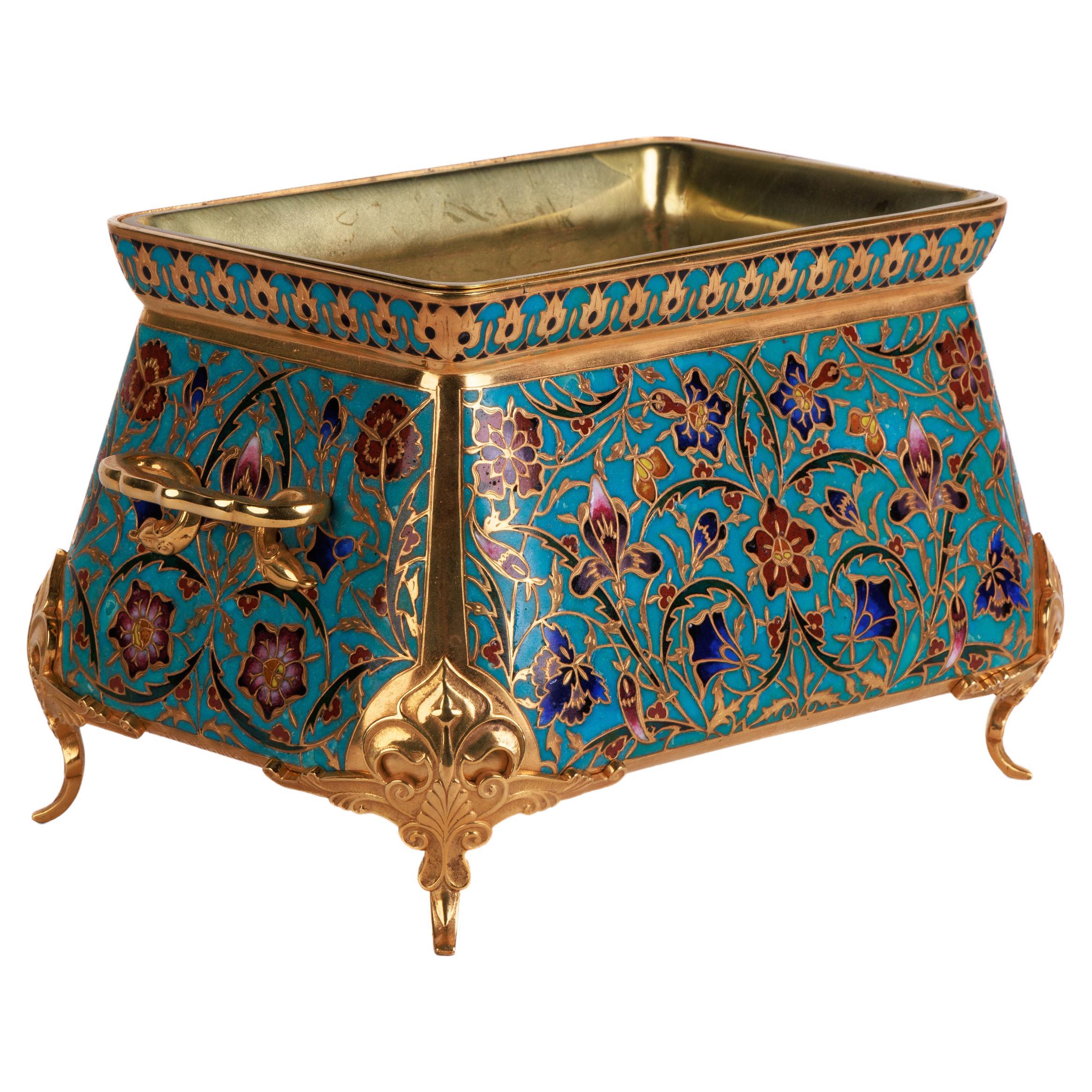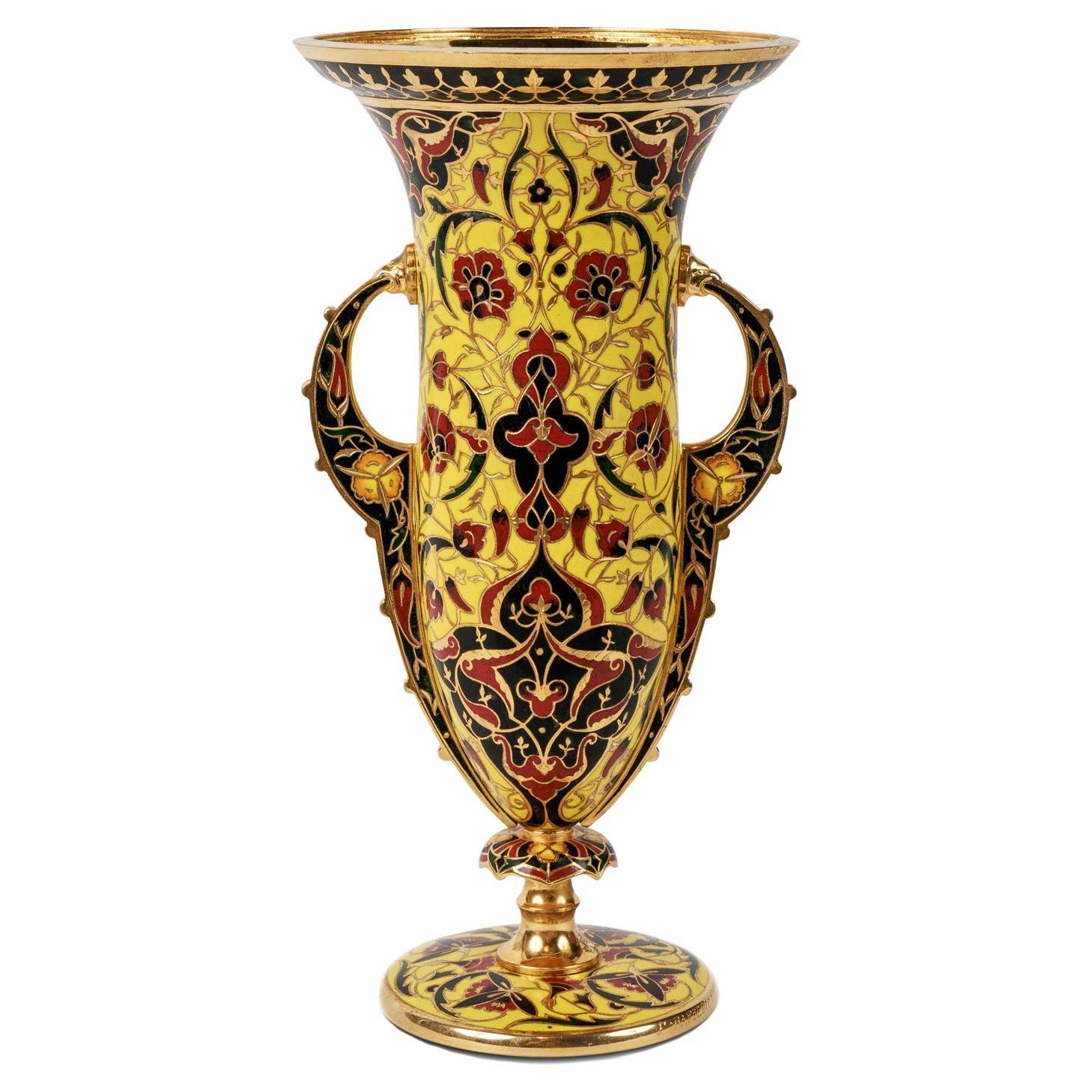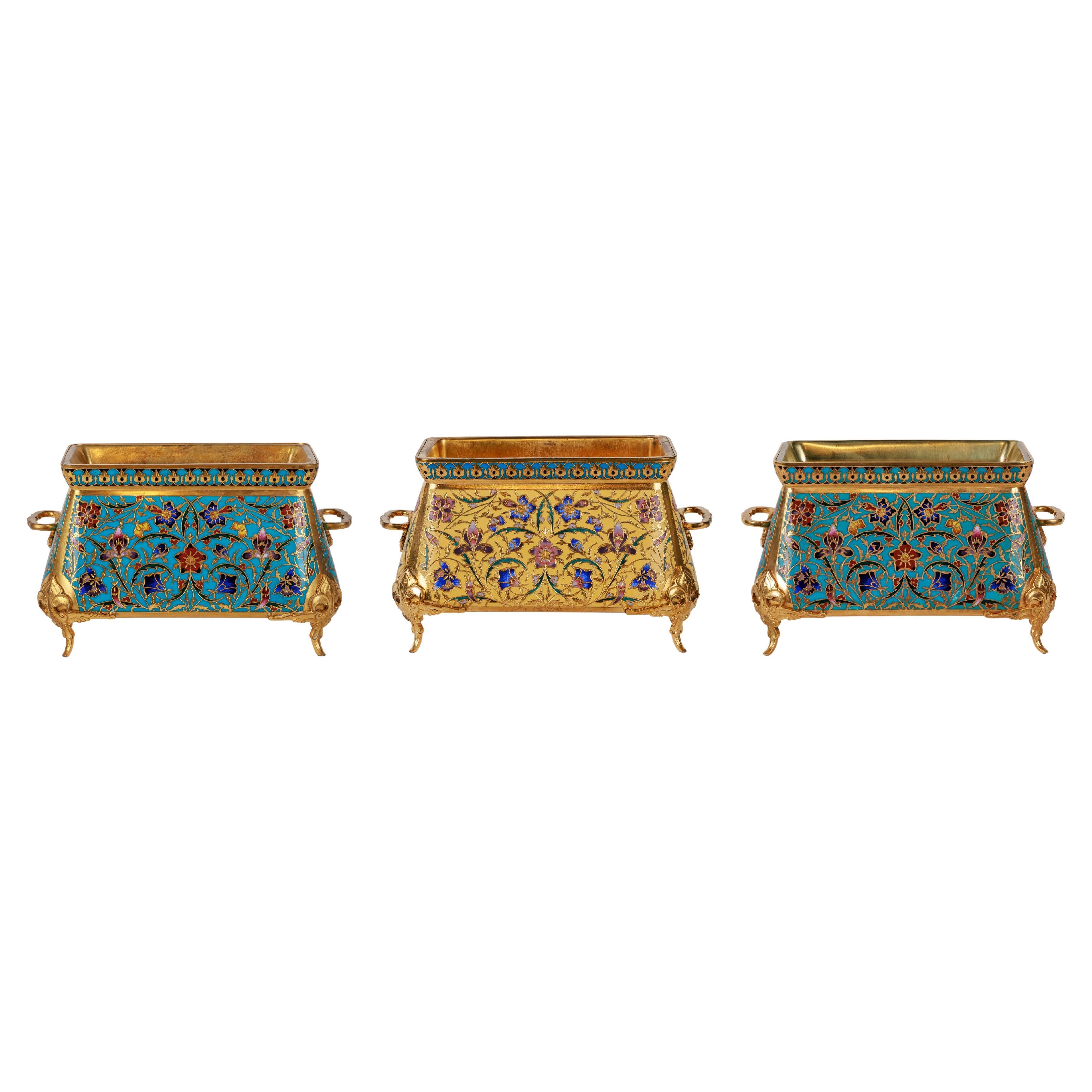Items Similar to French Champleve and Onyx Urns Barbedienne
Want more images or videos?
Request additional images or videos from the seller
1 of 18
French Champleve and Onyx Urns Barbedienne
About the Item
Onyx & Champleve Enamel
From our Decorative collection, we are delighted to offer this pair of French Champleve and Onyx Urns attributed to Barbedienne. The Urns of typical form with slightly tapered onyx waisted bodies having a ribbed centre section. The vases mounted with ormolu (gilt bronze) inlaid with champleve enamel and finished upon champleve stems with a flared base and large looped handles with good quality chased decoration. The Urns are firmly attributed to renowned French foundry and caster Ferdinand Barbedienne. The vases date to the late 19th century during the belle époque era circa 1875.
Ferdinand Barbedienne (1810-1892) Born in Saint-Pierre-en-Auge, Northwestern France. Barbedienne began life as a wallpaper salesman before going into partnership with Achille Collas in 1838 the founder of a mechanical device capable of replicating miniature models of famous sculptures. From 1838 Barbedienne grew substantially to become one of the most well known French founders and sculptures of the 19th century.
Ormolu is the technique of applying finely ground, high-carat gold–mercury amalgam to an object of bronze. The mercury is driven off in a kiln leaving behind a gold coating. The French refer to this technique as bronze doré and in English it is often referred to as gilt bronze. It is a finishing technique which adds an overall gold look to any object without the massive cost and impracticality of making an object out of solid gold. Mercury was outlawed in the 1830’s in France however it was still used until the early 1900s.
Bronze is a metal alloy consisting of copper, about 12% tin and often other metals such as aluminium, manganese, nickel, or zinc and sometimes, non-metals such as phosphorus, arsenic and, silicon. The additions produce a range of alloys that are harder than copper alone and often have other useful properties such as strength, ductility, and/or machinability.
Belle Epoque is a period of French, Belgian and European history. It began in the early 1870’s and to ended with the outbreak of World War I in 1914.
Champlevé is an enamelling technique in which troughs or cells are carved, etched, die struck, or cast into the surface of a metal object, and filled with vitreous enamel. This technique is not too dissimilar to Cloisonne however with Cloisonne the enamel is contained within thin walls of metal that have been soldered to the surface of the metal vase.
Measurements (centimetres) 31cm High x 17cm Wide x 15cm Deep
- Attributed to:Ferdinand Barbedienne (Manufacturer)
- Dimensions:Height: 12.2 in (30.99 cm)Width: 6.7 in (17.02 cm)Depth: 5.9 in (14.99 cm)
- Style:Belle Époque (Of the Period)
- Materials and Techniques:
- Place of Origin:
- Period:
- Date of Manufacture:Circa 1875
- Condition:Wear consistent with age and use. Minor fading.
- Seller Location:Newark, GB
- Reference Number:
About the Seller
5.0
Vetted Seller
These experienced sellers undergo a comprehensive evaluation by our team of in-house experts.
Established in 2019
1stDibs seller since 2022
18 sales on 1stDibs
Typical response time: 3 hours
- ShippingRetrieving quote...Ships From: Newark, United Kingdom
- Return PolicyA return for this item may be initiated within 14 days of delivery.
More From This SellerView All
- French Champlevé Onyx BoxBy Ferdinand BarbedienneLocated in Newark, EnglandFine 19th century French champlevé and onyx jewellery casket. The casket of rectangular form with four corner pillars, hinged lid and painted panel. The casket decorated extensively ...Category
Antique Late 19th Century French Napoleon III Decorative Boxes
MaterialsBronze, Enamel
- French Siena Marble Tazza Urns Charles XLocated in Newark, EnglandApplied Lyre Decoration The pair stood upon four cast Bronze feet with a pedestal Siena Marble foot with an applied bronze scrollwork border. The central square column with a bronze Swan neck lyre harp bordered by floral swags to the front of the vase. The base of each Tazza Urn cast in Bronze with Ram’s head twin loop handles and a floral band surmounted by a tapered Siena Marble Core finished with a Bronze liner. The Tazza Urns dating to the first half of the 19th century during the latter reign of Charles X circa 1830. Bronze an alloy consisting primarily of copper with approximately 12–12.5% tin and often with the addition of other metals (including aluminium, manganese, nickel, or zinc) and sometimes non-metals, such as phosphorus, or metalloids such as arsenic or silicon depending on the age of the bronze and its origin. The additions of other metals produce a range of alloys that are usually harder than copper alone and carry useful properties such as strength. The earliest known use of bronze dates to the 5th millennium BCE from Iranian plateau, the bronze mix consists of arsenical copper and copper-arsenide. The earliest tin-copper-alloy recovered is dated to circa 4650 BCE and was found in Plocnik, Serbia. It is believed to have been smelted from a natural tin-copper ore. Sienna Marble consists of various dark yellow and gold colours, it is extremely heterogeneous due to the presence of grains with shades ranging from ivory white to light yellow to a reddish yellow ocher and is usually an intense marble. Lyre a stringed musical instrument part of the lute-family and consists of two arms and a crossbar with strings. The Lyre has featured on classical objects like the pair of vases above for thousands of years. They were commonly used in several ancient cultures surrounding the Mediterranean Sea. The earliest known examples of the lyre have been recovered at archaeological sites that date to c. 2700 BCE in Mesopotamia. Charles X (Charles Philippe 1757-1836) was the King of France during a short reign between 1824 to 1830. He was the uncle of the uncrowned Louis XVII and younger brother to reigning kings Louis XVI and Louis XVIII, he supported the latter in exile. After the Bourbon Restoration in 1814, Charles (as heir-presumptive) became the leader of the ultra-royalists which was a radical monarchist faction within the French court. The ultra-royalists declared absolute monarchy by divine right and opposed the constitutional monarchy concessions towards liberals and the guarantees of civil liberties granted by the Charter of 1814. Charles gained...Category
Antique Early 19th Century French Charles X Urns
MaterialsMarble, Siena Marble, Metal, Bronze
- Grand Tour Sarrancolin Marble Tazza UrnLocated in Newark, EnglandFrench late 19th century grand tour style Sarrancolin marble tazza urn. The vase with coloured veins of reds, pinks and whites having a large flared opening...Category
Antique 19th Century French Grand Tour Planters, Cachepots and Jardinières
MaterialsMarble, Metal, Bronze
- French Gilded & Champleve Clock GarnitureLocated in Newark, EnglandFine French late 19th century three-piece clock garniture comprising of a pair of candle sticks and clock in a matching set. The garniture boldly cast with rococo influence in the Lo...Category
Antique Late 19th Century French Napoleon III Table Clocks and Desk Clocks
MaterialsMetal, Bronze, Enamel, Ormolu
- French Limoges Style Vase PairBy LimogesLocated in Newark, EnglandFine pair of late 19th century French limoge style enamel opposing vases. Each vase with a central female figure in 18th century dress amongst a vast fl...Category
Antique Late 19th Century French Art Nouveau Vases
MaterialsEnamel
- French 19th Century Gilded Bronze Dog Fremiet & BarbedienneBy F. Barbedienne Foundry, Emmanuel FremietLocated in Newark, EnglandFine 19th century French gilded bronze model of a dog. The bronze beautifully cast by renowned French sculptor Emmanuel Frémiet. Cast as a recumberant Samoyed on an elongasted oval b...Category
Antique Late 19th Century French Napoleon III Animal Sculptures
MaterialsBronze
You May Also Like
- Ormolu-Mounted and Champlevé Enamel Decorated Onyx Jardinière by BarbedienneBy Ferdinand BarbedienneLocated in New York, NYA fine quality large Neo-Grec gilt bronze-mounted and Champlevé enamel decorated onyx Jardinière by F. Barbedienne Maker: Ferdinand Barbedienne (1810-1892) Origin: French Date: ...Category
Antique Mid-19th Century French Planters, Cachepots and Jardinières
MaterialsOnyx, Bronze, Enamel
- Ferdinand Barbedienne, a French Ormolu and Champleve Enamel Jardiniere, C. 1870By Ferdinand Barbedienne, Louis-Constant SevinLocated in New York, NYFerdinand Barbedienne, A French Ormolu and Champleve Enamel Jardiniere, C. 1870, The Design Attributed to Louis Constant Sevin. An exceptional qualit...Category
Antique 19th Century French Napoleon III Decorative Bowls
MaterialsBronze, Enamel, Ormolu
- Ferdinand Barbedienne, A French Ormolu and Champleve Enamel Jardiniere, C. 1870By Ferdinand Barbedienne, Louis-Constant SevinLocated in New York, NYFerdinand Barbedienne, A French Ormolu and Champleve Enamel Jardiniere, C. 1870, The Design Attributed to Louis Constant Sevin. An exceptional qualit...Category
Antique 19th Century French Napoleon III Planters, Cachepots and Jardini...
MaterialsBronze, Enamel, Ormolu
- Ferdinand Barbedienne, A French Ormolu and Champleve Enamel Vase, C. 1870By Ferdinand BarbedienneLocated in New York, NYFerdinand Barbedienne, A French Ormolu and Champleve Enamel Vase, C. 1870 In the Islamic / Alhambra taste. The two handled vase in Alhambra form, enameled in rich yellow throughout ...Category
Antique 19th Century French Napoleon III Vases
MaterialsBronze, Ormolu, Enamel
- Ferdinand Barbedienne Set of Gilt Bronze-Mounted Champleve Onyx GarnitureBy Ferdinand BarbedienneLocated in Guaynabo, PRThis is a Ferdinand Barbedienne set of gilt bronze-mounted champleve onyx garniture. It consist of two urns and one large oval vase/jardiniere. The vase...Category
Antique Late 19th Century French Empire Garniture
MaterialsOnyx, Bronze
- F. Barbedienne, A Suite of Three French Ormolu and Champleve Enamel JardinieresBy Ferdinand BarbedienneLocated in New York, NYFerdinand Barbedienne, An Exquisite Suite of Three French Ormolu and Champleve Enamel Jardinieres / Garniture C. 1870, The Design Attributed to Louis Constant Sevin. Comprising of t...Category
Antique 19th Century French Napoleon III Planters, Cachepots and Jardini...
MaterialsBronze, Enamel, Ormolu
